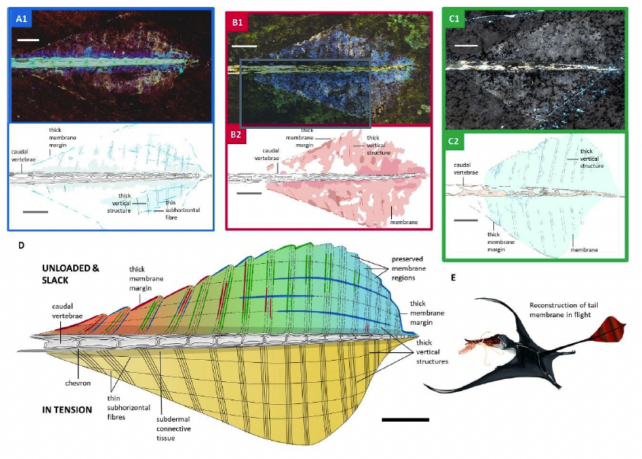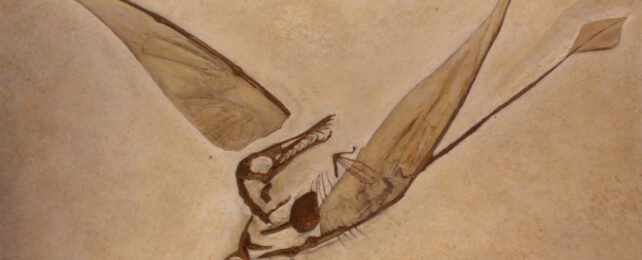The secret to pterosaurs taking flight long before birds and bats dominated the air was wasn't feathers or hollow bones.
Although those features no doubt helped, new research shows that a lattice-like structure stopped pterosaurs' broad-ended tails fluttering like flags in the wind and instead, once stiffened, helped guide these flying reptiles into the sky.
Pterosaurs took to the skies using powered flight about 215 million years ago, the first vertebrates to do so. Although they started out small, amongst their ranks were some of the largest flying animals in Earth's history.
Like birds, pterosaurs had feathers, but they weren't birds, nor were they bats. And although pterosaurs lived and died alongside dinosaurs, these flying reptiles weren't dinosaurs either but close cousins of them, evolving from upright-walking, rabbit-like creatures on a separate branch of the reptile family tree.
So what helped early pterosaurs win the evolutionary race of vertebrate flight? For a long time, we haven't had a clear idea. But a new study, not yet peer-reviewed, suggests that it was the stiffness of their tail vane, which are broadly diamond-shaped and have been thought of as steering aids.
Pterosaurs are relatively rare in the fossil record because their thin and hollow bones – which would have been great for flying – are easily degraded by the grains of time. Traces of soft tissue are ever rarer, with skin, organs and connective tissue disintegrating much faster than bone.
To have a handful of pterosaurs preserved well enough for the fossils to retain details of the thin, soft tissue tail vane, well that is something to behold indeed.
University of Edinburgh palaeontologist Natalia Jagielska and colleagues pored over 100 pterosaur fossils held in various museum collections, to find four "exceptional specimens" that fluoresced pink and white under UV light, indicating soft tissue structures had been preserved.
"Maintaining stiffness in the [tail] vane would have been crucial in early pterosaur flight, but how this was achieved has been unclear, especially since vanes were lost in later pterosaurs and are absent in birds and bats," Jagielska and colleagues explain in their preprint, which has been shared on the bioRxiv preprint server.
Imaging the four specimens with a technique called laser-stimulated fluorescence revealed hidden anatomical details in the pterosaurs' tail vanes: thick, vertical rods projecting out of the central tail bone laced with thinner fibers to create a cross-linked lattice that prevented the tail vane from bending out of shape, reducing drag and stabilizing flight.
"The vane was stiffened by a rod-like lattice structure, which offered greater stabilization and control during flight," paleontologist Jamale Ijouiher, who was not involved in the study, explained on X (formerly Twitter).

Tail vanes, like pterosaurs themselves, however, come in sorts of sizes, and this study only analyzed four fossils of long-tailed Rhamphorhynchus pterosaurs. Yet the researchers think the specimens still reveal some details about how the structures evolved.
"The new soft tissue information also provides clues about the evolutionary origins of the tail vane itself," Jagielska and colleagues write.
"The cross-linked lattice recognized in this study suggests that the tail vane of early pterosaurs developed from a single contiguous structure rather than a combined structure of scales or feather-like integuments."
The researchers also deduced from imaging that pterosaur tail vanes likely contained "fleshy folds" at the end, and might have developed similar to the flukes of cetaceans that help whales and dolphins glide through water.
Another body part thought to be crucial to pterosaurs taking flight was a tendon called the propatagium, which stretches along the leading edge of the wing, connecting the equivalent of our wrist and shoulder joints. It likely controlled flight take-off and landing by altering the flow of air over each wing's upper surface.
But today's birds and bats also have a propatagium on each wing, so it wasn't distinctive like the pterosaur's oar-like tail vane.
The research has been posted to bioRxiv ahead of peer review.
